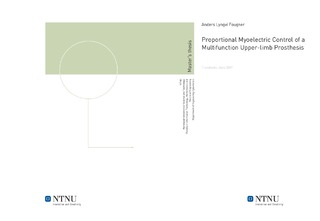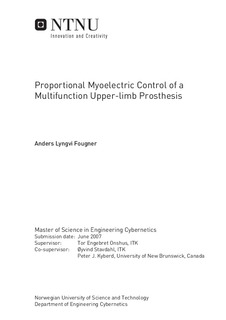| dc.description.abstract | This study is a part of a renew and continuation of the SVEN work done in Sweden in the later 1970's. The SVEN hand was an on/off-controlled upper-limb prosthesis based on measured electromyographic (EMG) signals. Recently the SVEN methods have been revived in a cooperation by NTNU and UNB, Canada. The aim of this study is to further develop a practical porportional control system for a multifunction upper-limb prosthesis. This is based on a hypothesis that a simple and smooth proportional control system will be easier for the central nervous system to adapt to, compared to existing systems, and will thus provide increased functionality for the user. A protocol has been developed for the recording of EMG signals and VICON motion measurements in a laboratory. Suitable data sets have been recorded from three test subjects, and signal processing and three pattern recognition methods have been applied on these data sets to generate estimates of clinical angles. The pattern recognition methods tested were linear (LF) and quadratic (QF) mapping functions and multi-layer perceptron (MLP) network. The performance of these methods has been evaluated, compared and visualized. More testing is needed to find the best method, and the MLP network can be improved in several ways. To achieve better angle estimates that can be used for proportional control of prostheses, we wanted to use EMG signal features that are insensitive to amplitude changes due to variations in skin conductance. Qualitative and quantitative EMG signal features are described with this property as an important concern. The zero-crossings (ZC) feature has been tested as one of these, also in combination with the averaged absolute value (AAV). Although ZC did not always perform superior to AAV, it is likely that other features and combinations of these should be tested. Inclusion of other properties from the prosthesis, like elbow angle or measured pressure from the arm on the prosthesis, can also be included to improve the estimates. We now have a large, suitable data set from the laboratory, which can be used for further work on pattern recognition and multifunction proportional control of prostheses. There are also other applications for the methods developed. The final step will hopefully be implementation in a real prosthesis. | nb_NO |

